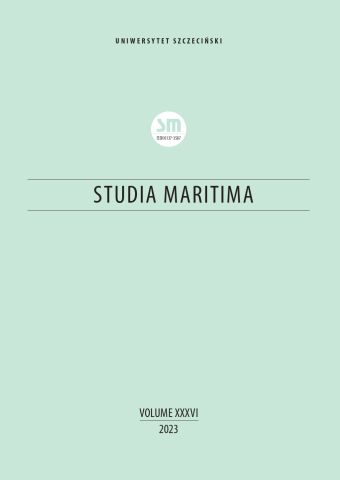






| Authors: |
Carina
Damm

Leibniz Institute for the History and Culture of Eastern Europe (GWZO), Leipzig |
| Keywords: | emporia early medieval trade Viking Age Old Norse literature slavery |
| Data publikacji całości: | 2023 |
| Page range: | 19 (49-67) |
| 1. | Primary sources |
| 2. | Adam of Bremen. History of the Archbishops of Hamburg-Bremen. Translated by Francis J. Tschan. Records of Civilisation. Sources and Studies. New York: Columbia University Press, [1959], 2002. |
| 3. | Björn K. Þórólfsson, and Guðni Jónsson, eds. Gísla saga Súrssonar. Íslenzk fornrit 6. Reykjavík: Hið íslenzka fornritafélag, 1943. |
| 4. | Chase, Colin, ed. Two Alcuin Letter-books. Toronto Medieval Latin Texts 5. Toronto: The Centre for Medieval Studies by the Pontifical Institute of Mediaeval Studies, 1975. |
| 5. | Einar Ól. Sveinsson, ed. Njáls saga. Íslenzk fornrit 12. Reykjavik: Hið íslenzka fornritafélag, 1954. |
| 6. | Einhard. “Annales regni Francorum.” In: Monumenta Germaniae Historica, Scriptores rerum Germanicarum in usum Scholarum. Vol. 6. Edited by Friedrich Kurze. Hannover: Hahn 1895. |
| 7. | Finnur Jónsson, ed. Fagrskinna. Nóregs konunga tal. København: Møller, 1902–1903. |
| 8. | Guðbrandur Vigfússon, and C. R. Unger, eds. “Hamborgar históría.” In: Flateyjarbók: En Samling af norske Konge-Sagaer med indskudte mindre Fortællinger om Begivenheder i og udenfor Norge samt Annaler I. Oslo: P.T. Malling, 1860. |
| 9. | Kålund, Kristian, ed. “Landafrœði” (Alfræði íslenzk. Islandsk encyklopædisk litteratur. 1. Cod. MBR AM 194,8vo). In: Samfund til Udgivelse af Gammel Nordisk Literatur 37. København: Møller, 1908. |
| 10. | Schmeidler, Bernhard, ed. “Magistri Adam Bremensis Gesta Hammmaburgensis Ecclesiae Pontificum.” In: Monumenta Germaniae Historica. Scriptores rerum Germanicarum in usum scholarum. Hannover: Hahn, 1917. |
| 11. | Snorri Sturluson, Heimskringla I, eds. Alison Finlay, and Anthony Faulkes. London: Viking Society for Northern Research, 2016. |
| 12. | Holtzmann, Robert, ed. “Thietmari Merseburgensis episcopi chronicon.” In: Monumenta Germaniae Historica. Scriptores rerum Germanicarum. Nova series. Vol. 9. Berlin: Weidmann, 1935. |
| 13. | Waitz, Georg, ed. “Rimberti Vita Anskari.” In: Monumenta Germaniae Historica Scriptores rerum Germanicurum in usum scholarum. Vol. 55. Hannover: Hahn, 1884. |
| 14. | References |
| 15. | Auge, Oliver. “Ostseeraum.” In: Migrationen im Mittelalter: Ein Handbuch, ed. Michael Borgolte. 193–208. Berlin/München/Boston: De Gruyter, 2014. |
| 16. | Biermann, Felix. “Archaeological Evidence for Slavery Among the Early Medieval North- Western Slavs.” In: The Archaeology of Slavery in Early Medieval Northern Europe: The Invisible Commodity, eds. Felix Biermann, and Marek Jankowiak, 141–160. Cham: Springer, 2021. |
| 17. | Biermann, Felix. “Zentralisierungsprozesse bei den nördlichen Elbslawen.” In: Zentralisierungsprozesse und Herrschaftsbildung im frühmittelalterlichen Ostmitteleuropa. Studien zur Archäologie Europas 23, ed. Przemysław Sikora, 157–194. Bonn: Habelt, 2014. |
| 18. | Bogucki, Mateusz. “On Wulfstan’s Right Hand – the Viking Age Emporia in West Slav Lands.” In: From One Sea to Another. Trading Places in the European and Mediterranean Early Middle Ages. Proceedings of the International Conference, Commacchio, 27th–29th March 2009, eds. Sauro Gelichi, and Richard Hodges, 81–109. Turnhout: Brepols, 2012. |
| 19. | Croix, Sarah. “The Vikings, Victims of their Own Success? A Selective View on Viking Research and its Dissemination.” Danish Journal of Archaeology 4 (2015), 1: 82–96. DOI: 0.1080/21662282.2015.1133944. |
| 20. | Gardeła, Leszek. “Vikings in Poland. A Critical Overview.” In: Viking Worlds: Things, Spaces and Movement, eds. Marianne Hem Eriksen, Unn Pedersen, Bernt Rundberget, Irmelin Axelsen, and Heidi Lund Berg, 213–234. Oxford: Oxbow Books, 2015. |
| 21. | Gazzoli, Laura Amalasunta. “Cnut, his Dynasty, and the Elbe-Slavs.” In: Anglo-Danish Empire. A Companion to the Reign of King Cnut the Great, eds. Richard North, Erin Goeres, and Alison Finlay, 399–417. Berlin/Boston: De Gruyter, 2022. |
| 22. | Gazzoli, Paul. “Review of King Harold’s Cross Coinage edited by Jens Christian Moesgaard, Maria Filomena Guerra, Gitta Tarnow Ingvardson, Peter Ilisch, Peter Pentz and Hans Skov.” Revue Belge de Numismatique 163 (2017): 469–472. |
| 23. | Gruszczyński, Jacek, Marek Jankowiak, and Jonathan Shepard, eds. Viking-Age Trade. Silver, Slaves and Gotland. London/New York: Routledge, 2021. |
| 24. | Hackmann, Jörg. “From Germania Slavica to Slavia Germanica?”. Studia Slavica et Balcanica Petropolitana 2 (2017) 22: 122–132. |
| 25. | Hedenstierna-Jonson, Charlotte. “Entering the Viking Age.” In: Relations and Runes: The Baltic Islands and their Interactions during the Late Iron Age and Early Middle Ages, eds. Charlotte Hedenstierna-Jonson, Laila Kitzler Åhfeldt, Per Widerström, and Ben Raffield, 11–22. Visby: Riksantikvarieämbetet, 2020. |
| 26. | Hilberg, Volker. “Auf der Suche nach dem Niedergang eines Handelsplatzes: Haithabu in der jüngeren Wikingerzeit”. In: Geophysik und Ausgrabung; Einsatz und Auswertung zerstörungsfreier Prospektion in der Archäologie, eds. Martin Posselt, Benno Zickgraf, and Claus Dobiat, 187–203. Rahden: Leidorf, 2007. |
| 27. | Hodges, Richard. Dark Age Economics. The Origins of Towns and Trade, AD 600–1000. London: Duckworth, 1982. |
| 28. | Jankowiak, Marek. “Tracing the Saqaliba: Slave Trade and the Archaeology of the Slavic Lands in the Tenth Century.” In: The Archaeology of Slavery in Early Medieval Northern Europe: The Invisible Commodity, eds. Felix Biermann, and Marek Jankowiak, 161–181. Cham: Springer, 2021. |
| 29. | Jankowiak, Marek. “The Flows of Dirhams to North-eastern Europe and the Rhythms of the Slave Trade with the Islamic World.” In: Viking-Age Trade: Silver, Slaves and Gotland, eds. Jacek Gruszczyński, Jonathan Shepard, and Marek Jankowiak, 105–131. London/New York: Routledge, 2021. |
| 30. | Jankowiak, Marek. “Two Systems of Trade in the Western Slavic Lands in the 10th Century.” In: Economies, Monetisation and Society in the West Slavic Lands, eds. Mateusz Bogucki and Marian Rębkowski, 137–148. Szczecin: Wydawnictwo IAE PAN; Wydawnictwo WH US, 2013. |
| 31. | Jesch, Judith. Ships and Men in the Late Viking Age. The Vocabulary of Runic Inscriptions and Skaldic Verse. Woodbridge: Boydell & Brewer, 2001. |
| 32. | Jöns, Hauke, and Anna Kowalska. “Scandinavians on the Southern Baltic Coast.” In: Vikings Across Boundaries. Viking-Age Transformations, eds. Hanne Lovise Aannestad et al., 42–59. Vol. 2. London/New York: Routledge, 2021. |
| 33. | Jöns, Hauke, and Sebastian Messal. “Neue Forschungen zur Struktur mittelalterlicher Hafenanlagen an der südwestlichen Ostseeküste.” In: Economies, Monetisation and Society in the West Slavic Lands 800–1200 AD, eds. Mateusz Bogucki, and Marian Rębkowski, 25–43. Szczecin: Wydawnictwo IAE PAN; Wydawnictwo WH US, 2013. |
| 34. | Kalmring, Sven. Der Hafen von Haithabu. Neumünster: Wachholtz, 2010. |
| 35. | Laur, Wolfgang. “Sprachen, Schriften, ‘Nationalitäten’ in Haithabu und Schleswig.” In: Von Thorsberg nach Schleswig: Sprache und Schriftlichkeit eines Grenzgebietes im Wandel eines Jahrtausends, eds. Klaus Düwel, Edith Marold, and Christiane Zimmermann, 61–76. Berlin/Boston: De Gruyter, 2001. |
| 36. | Lübke, Christian. “Östliches Europa (Kolonisationen).” In: Migrationen im Mittelalter: Ein Handbuch, ed. Michael Borgolte, 181–192. Berlin: De Gruyter, 2017. |
| 37. | Lübke, Christian. “Die Beziehungen zwischen Elb- und Ostseeslawen und Dänen vom 9. bis zum 12. Jahrhundert: Eine andere Option elbslawischer Geschichte?” In: Zwischen Reric und Bornhöved. Die Beziehungen zwischen den Dänen und ihren slawischen Nachbarn vom 9. bis ins 13. Jh., eds. Ole Harck, and Christian Lübke, 24–25. Stuttgart: Steiner, 2001. |
| 38. | Moesgaard, Jens Christian, Maria Filomena Guerra, Gitte Tarnow Ingvardson, Lutz Ilisch, Peter Ilisch, Peter Pentz, and Hans Skov, eds. King Harold’s Cross Coinage: Christian Coins for the Merchants of Haithabu and the King’s Soldiers (Studies in Archaeology and History 20.2). Copenhagen: University Press of Southern Denmark, 2015. |
| 39. | Loveluck, Christopher. Northwest Europe in the Early Middle Ages, c. AD 600–1150. Cambridge: Cambridge University Press, 2013. |
| 40. | Lund, Julie, and Søren Michael Sindbæk. “Crossing the Maelstrom: New Departures in Viking Archaeology.” Journal of Archaeological Research 30 (2022): 169–229. DOI: 10.1007/s10814-021-09163-3. |
| 41. | Marold, Edith. “Haithabu in der altisländischen Literatur.” In: Von Thorsberg nach Schleswig: Sprache und Schriftlichkeit eines Grenzgebietes im Wandel eines Jahrtausends, eds. Düwel, Klaus, Edith Marold, and Christiane Zimmermann, 77–100. Berlin/Boston: De Gruyter, 2001. |
| 42. | Morawiec, Jakub. “Slavs and Their Lands.” In: Scandinavian Culture in Medieval Poland, eds. Sławomir Moździoch, Błażej Stanisławski, and Przemysław Wiszewski, 53–64. Wrocław: Institute of Archaeology and Ethnology of the Polish Academy of Sciences, 2013. |
| 43. | Näsman, Ulf. “Exchange and Politics: the Eighth–Early Ninth Century in Denmark.” In: The Long Eighth Century: Production, Distribution and Demand, eds. Chris Wickham, and Inge Lyse Hansen, 35–68. Leiden/Boston: Brill, 2000. |
| 44. | Naum, Magdalena. “Convivencia in a Borderland: The Danish-Slavic Border in the Middle Ages.” Archaeological Review from Cambridge 28 (2013), 1: 75–93. |
| 45. | Ness, Immanuel, ed. The Encyclopedia of Global Human Migration. Chichester; Malden, Mass.: Wiley-Blackwell, 2013. |
| 46. | Petrulevich, Alexandra. “On the etymology of at Jómi, Jumne and Jómsborg.” Namn och bygd 97 (2009): 65–97. |
| 47. | Price, T. Douglas, Jüri Peets, Raili Allmäe, Liina Maldre, and Ester Oras. “Isotopic Provenancing of the Salme Ship Burials in Pre-Viking Age Estonia.” Antiquity 90 (2016), 352: 1022–1037. DOI: 10.15184/aqy.2016.106. |
| 48. | Radtke, Christian, Wolfgang Laur, and Ralf Wiechmann. “Haiðaby.” In: Reallexikon der Germanischen Altertumskunde 13. Second fully revised and greatly enlarged edition. Edited by Heinrich Beck, Dieter Geuenich, and Heiko Steuer, 362–386. Berlin/Boston: De Gruyter, 1999. |
| 49. | Simek, Rudolf, and Hermann Pálsson, eds. “Leiðarvísir.” In: Lexikon der altnordischen Literatur. Stuttgart: Kröner 2007, 246–47. |
| 50. | Sindbæk, Søren M. “Urbanism and Exchange in the North Atlantic/Baltic, 600–1000 CE.” In: The Routledge Handbook of Archaeology and Globalization, ed. Tamar Hodos, 556–557. New York/London: Routledge, 2017. |
| 51. | Sindbæk, Søren M. “Routes and Long-distance Traffic – The Nodal Points of Wulfstan’s Voyage.” In: Wulfstan’s Voyage: The Baltic Sea Region in the Early Viking Age |
| 52. | as Seen from Shipboard, eds. Anton Englert and Athena Trakadas, 72–78. Roskilde: The Viking Ship Museum, 2009. |
| 53. | Sindbæk, Søren M. “The Small World of the Vikings: Networks in Early Medieval Communication and Exchange.” Norwegian Archaeological Review 40 (2007): 59–74. |
| 54. | Waßenhoven, Dominik. Skandinavier unterwegs in Europa (1000–1250). Untersuchungen zu Mobilität und Kulturtransfer auf prosopographischer Grundlage. Berlin: Akademie Verlag, 2006. |
| 55. | Whaley, Diana. “Arnórr jarlaskáld Þórðarson, Hrynhenda, Magnússdrápa 12.” In: Poetry from the Kings’ Sagas 2: From c. 1035 to c. 1300. Skaldic Poetry |
| 56. | of the Scandinavian Middle Ages, ed. Kari Ellen Gade, 197–198. Vol. 2. Turnhout: Brepols, 2009. |